Web Infantry Equipment, Pattern 1944
Haversacks and Rucksack
Stores Ref. A6/AF 0262 Haversack, All Ranks, W.E. Patt. ‘44
Stores Ref. A1/AA 2007 Haversack, All Ranks, W.E. Patt. ‘44
Stores Ref. CN/AA 2007 Web Equipment Patt. ’44, Haversack, All Ranks
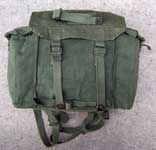


 Although of greater capacity than its Patt. ’37 counterpart, this new design was not really big enough, which would be addressed nearly two decades later. Nothing like it had been made by Mills, since a design for the Spanish infantry in 1918 (Mills Patent 12975/1918; also see Lethern p. 30). The sides had large pockets, with gusseted flaps secured by QR fasteners. They were large enough to contain one half of the aluminium Mess Tins. Above each pocket, set in the junction of pocket to Haversack body was an angle chape and 1-inch buckle. This allowed the Haversack to be carried at the left side, attached to the Brace ends, when in Full Marching Order. The inside front, rear and base sections were lined with waterproof material, which also faced the inside of the main flap. Stitched on the outside of the flap was a tapered tab, with two eyelets (grommets in Army parlance). Adjacent to this was a short strap closed by a Quick Release Buckle (QRB), the inside face reinforced with an extra layer of strapping. The Entrenching tool carrier (based on U.S. M-1943 Carrier) was attached by a hanger hook to the tab, the helve held to the Haversack by a short strap and plain buckle, stitched at the bottom of the front face. As an alternative, the upper strap and QRB could hold a pickaxe, the helve again held in place by the lower short strap. Another novel feature were bedding straps, stitched to the base and secured by QRBs. The strap as stitched inside a loose sleeve, which allowed the straps to be folded and stowed away, when not in use. The base carried angle 3/4-inch buckles and the rear face had the usual 2-inch tabs, but with transverse loops to tuck away the loose ends of the Shoulder straps. Two halves of a waist strap were stitched at the bottom of the rear face, though the positioning made it more of a chest strap. Whilst this added stability and reduced “pack bounce”, it constricted the chest and was often left un-fastened.
Although of greater capacity than its Patt. ’37 counterpart, this new design was not really big enough, which would be addressed nearly two decades later. Nothing like it had been made by Mills, since a design for the Spanish infantry in 1918 (Mills Patent 12975/1918; also see Lethern p. 30). The sides had large pockets, with gusseted flaps secured by QR fasteners. They were large enough to contain one half of the aluminium Mess Tins. Above each pocket, set in the junction of pocket to Haversack body was an angle chape and 1-inch buckle. This allowed the Haversack to be carried at the left side, attached to the Brace ends, when in Full Marching Order. The inside front, rear and base sections were lined with waterproof material, which also faced the inside of the main flap. Stitched on the outside of the flap was a tapered tab, with two eyelets (grommets in Army parlance). Adjacent to this was a short strap closed by a Quick Release Buckle (QRB), the inside face reinforced with an extra layer of strapping. The Entrenching tool carrier (based on U.S. M-1943 Carrier) was attached by a hanger hook to the tab, the helve held to the Haversack by a short strap and plain buckle, stitched at the bottom of the front face. As an alternative, the upper strap and QRB could hold a pickaxe, the helve again held in place by the lower short strap. Another novel feature were bedding straps, stitched to the base and secured by QRBs. The strap as stitched inside a loose sleeve, which allowed the straps to be folded and stowed away, when not in use. The base carried angle 3/4-inch buckles and the rear face had the usual 2-inch tabs, but with transverse loops to tuck away the loose ends of the Shoulder straps. Two halves of a waist strap were stitched at the bottom of the rear face, though the positioning made it more of a chest strap. Whilst this added stability and reduced “pack bounce”, it constricted the chest and was often left un-fastened.


 Side (far left), top (centre left), and bottom (near left) view of the Haversack shown above.
Side (far left), top (centre left), and bottom (near left) view of the Haversack shown above.
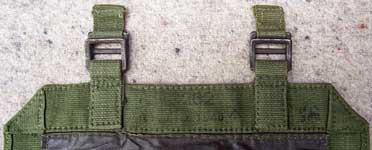
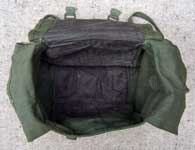 Marking and interior details of the Haversack shown above. Note the waterprook lining. This example is maker marked "M.E. Co." and dated 1946. From the David Gordon Collection. All photos this of this Haversack are © David Gordon 2009.
Marking and interior details of the Haversack shown above. Note the waterprook lining. This example is maker marked "M.E. Co." and dated 1946. From the David Gordon Collection. All photos this of this Haversack are © David Gordon 2009.
 Rog Dennis has located this very interesting photo, the only one we've seen showing this Haversack actually being carried (exceedingly awkwardly, we must admit) on the Brace ends. Obviously just returning from Eastern climes, he appears to have a Patt. '37 Pack as well.
Rog Dennis has located this very interesting photo, the only one we've seen showing this Haversack actually being carried (exceedingly awkwardly, we must admit) on the Brace ends. Obviously just returning from Eastern climes, he appears to have a Patt. '37 Pack as well.
There was also a second, larger, version of the Haversack, All ranks, that was issued in 1965. That Haversack is detailed on the NATO (CN coded Equipment) page.
Stores Ref. A6/AF 0263 Haversack, Officers, W.E. Patt. ‘44
Stores Ref. A1/AA 2008 Haversack, Officers, W.E. Patt. ‘44
Stores Ref. CN/AA 2008 Web Equipment Patt. ’44, Haversack, Officers

 As with Patt. ’37, the particular requirements of officers were catered for by this narrow cross-section item. Its interior was undivided, but lined on body and flap with waterproof material. The flap closed with a simple buckle, with rear face buckles for attachment to the Brace ends. A carrying handle was fitted to the upper rear face, as with the Patt. ’37 version.
As with Patt. ’37, the particular requirements of officers were catered for by this narrow cross-section item. Its interior was undivided, but lined on body and flap with waterproof material. The flap closed with a simple buckle, with rear face buckles for attachment to the Brace ends. A carrying handle was fitted to the upper rear face, as with the Patt. ’37 version.


 Rear views of the same Haversack (far and centre left) and a view from the top (near left) showing the lined waterproof interior. Unfortunately, the maker's mark and date are illegible on this example from the David Gordon Collection. All photos this of this Haversack are © David Gordon 2009.
Rear views of the same Haversack (far and centre left) and a view from the top (near left) showing the lined waterproof interior. Unfortunately, the maker's mark and date are illegible on this example from the David Gordon Collection. All photos this of this Haversack are © David Gordon 2009.


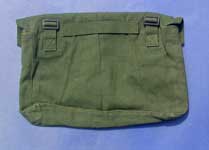 Another example of the Haversack, officers. This one is a bit unusual in having grey-green anodised fittings, instead of the usual green. Also unusual for a 1961 dated example, it is not coded. This Haversack is maker marked "M.E. Co." It is from the Ed Storey Collection. Photographs © Ed Storey 2010.
Another example of the Haversack, officers. This one is a bit unusual in having grey-green anodised fittings, instead of the usual green. Also unusual for a 1961 dated example, it is not coded. This Haversack is maker marked "M.E. Co." It is from the Ed Storey Collection. Photographs © Ed Storey 2010.
Stores Ref. A6/AF 0271 Rucksack, W.E. Patt. ‘44
Stores Ref. A1/AA 2016 Rucksack, W.E. Patt. ‘44
Stores Ref. CN/AA 2016 Web Equipment Patt. ’44, Rucksack
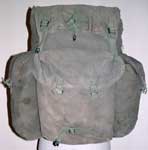

 Like the M.T. drivers Pouch, this was again an afterthought. Arranged alphabetically, it should have taken a lower code than Straps, shoulder, haversack. This was a far larger envelope, which proved popular with troops, though it had no concessions to the science of “packology”. It was simply a large sac, with no stiffening or padding, though it could be fitted to the Carrier, manpack, G.S. (yet to be covered by KW). Its exterior had three large pockets, in typical civilian rucksack style, all of which had hooded flaps, secured by QR fasteners. A fourth pocket, internally partitioned into three sections and closed with QR fasteners, was located on the underside of the QR fastened flap. Tabs and base buckles, both with tidy-away loops, allowed connection to the standard Haversack straps. Three metal loops were stitched into the rear vertical seams, which allowed for attachment to the Man Pack Carrier. No eyeleted tab was fitted, just the upper (flap) and lower (body) straps for carrying an entrenching tool. The mouth of the main body is closed, firstly by a secondary flap in the mouth, over which the main body is closed - kitbag style - by means of large eyelets, with a tie tape, rather than cord.
Like the M.T. drivers Pouch, this was again an afterthought. Arranged alphabetically, it should have taken a lower code than Straps, shoulder, haversack. This was a far larger envelope, which proved popular with troops, though it had no concessions to the science of “packology”. It was simply a large sac, with no stiffening or padding, though it could be fitted to the Carrier, manpack, G.S. (yet to be covered by KW). Its exterior had three large pockets, in typical civilian rucksack style, all of which had hooded flaps, secured by QR fasteners. A fourth pocket, internally partitioned into three sections and closed with QR fasteners, was located on the underside of the QR fastened flap. Tabs and base buckles, both with tidy-away loops, allowed connection to the standard Haversack straps. Three metal loops were stitched into the rear vertical seams, which allowed for attachment to the Man Pack Carrier. No eyeleted tab was fitted, just the upper (flap) and lower (body) straps for carrying an entrenching tool. The mouth of the main body is closed, firstly by a secondary flap in the mouth, over which the main body is closed - kitbag style - by means of large eyelets, with a tie tape, rather than cord.
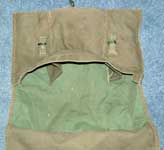
 Details of the Rucksack shown above. Far left, the divided pocket on the interior of the flap. Near left, almost unreadable stamping detail. The Rucksack is maker marked "M.E. Co." and dated 1946. Interestingly, it is stamped with a duff code "AF./2071", with the numerals transposed from the correct AF 0271. This example is from the Allen Prior Collection. Photographs © Allen Prior 2009.
Details of the Rucksack shown above. Far left, the divided pocket on the interior of the flap. Near left, almost unreadable stamping detail. The Rucksack is maker marked "M.E. Co." and dated 1946. Interestingly, it is stamped with a duff code "AF./2071", with the numerals transposed from the correct AF 0271. This example is from the Allen Prior Collection. Photographs © Allen Prior 2009.

 Unlike the other components of Patt. ’44, the material used was thin, fine-weave cotton duck, rubberised inside for waterproofing. This is brought out in the 1945 photograph of a Royal Artillery Staff Sergeant shown at near right. The brand new – and green – Rucksack contrasts sharply with the khaki webbing. The same material was used on later examples of the Bergen “A” frame Rucksack. It is also a prototype, as the upper E.T. strap is on the body, not the flap. The Rucksack is strapped to a Carrier, man pack, G.S. 1945, normally fitted with S.C.C. 19 straps, but here they are khaki. The photo far right was taken in Malaya during the Malayan Emergency. It shows a W.E. Patt. '44 Rucksack mounted on a cut-down G.S. Manpack carrier. Both of these very interesting photos were provided to Karkee Web by Allen Prior.
Unlike the other components of Patt. ’44, the material used was thin, fine-weave cotton duck, rubberised inside for waterproofing. This is brought out in the 1945 photograph of a Royal Artillery Staff Sergeant shown at near right. The brand new – and green – Rucksack contrasts sharply with the khaki webbing. The same material was used on later examples of the Bergen “A” frame Rucksack. It is also a prototype, as the upper E.T. strap is on the body, not the flap. The Rucksack is strapped to a Carrier, man pack, G.S. 1945, normally fitted with S.C.C. 19 straps, but here they are khaki. The photo far right was taken in Malaya during the Malayan Emergency. It shows a W.E. Patt. '44 Rucksack mounted on a cut-down G.S. Manpack carrier. Both of these very interesting photos were provided to Karkee Web by Allen Prior.


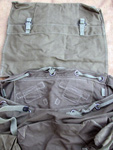
 Another example of the W.E. Patt. '44 Rucksack, this one unissued, maker marked "M.E. Co.", and dated 1945. Unlike the 1946 dated Rucksack shown above, this one has the stores code "AF./0271" printed correctly. From the WD Militaria website, used by permission of Paul Laidlaw. Photos © Pail Laidlaw 2013.
Another example of the W.E. Patt. '44 Rucksack, this one unissued, maker marked "M.E. Co.", and dated 1945. Unlike the 1946 dated Rucksack shown above, this one has the stores code "AF./0271" printed correctly. From the WD Militaria website, used by permission of Paul Laidlaw. Photos © Pail Laidlaw 2013.
A6/AF 0002 BAGS, Pack, Waterproof

 This was not given the nomenclature of Patt. ’44 W.E., so was not transferred to Section A1 when LoC C 4686 was authorised in 1951. It was one of many and varied “Non-Patterned” items in Section A6 Jungle Warfare Equipment.
This was not given the nomenclature of Patt. ’44 W.E., so was not transferred to Section A1 when LoC C 4686 was authorised in 1951. It was one of many and varied “Non-Patterned” items in Section A6 Jungle Warfare Equipment.
Although the Rucksack was made of rubberised canvas, the wet conditions prevalent in jungles merited extra water-proofing, in the form of a rubberised bag.
 This was a forerunner - with a long gap in-between – of three sizes of Bags, insertion developed for use with Patt. ’90 PLCE. From the Allan Prior Collection. Photographs © Allan Prior, 2016.
This was a forerunner - with a long gap in-between – of three sizes of Bags, insertion developed for use with Patt. ’90 PLCE. From the Allan Prior Collection. Photographs © Allan Prior, 2016.